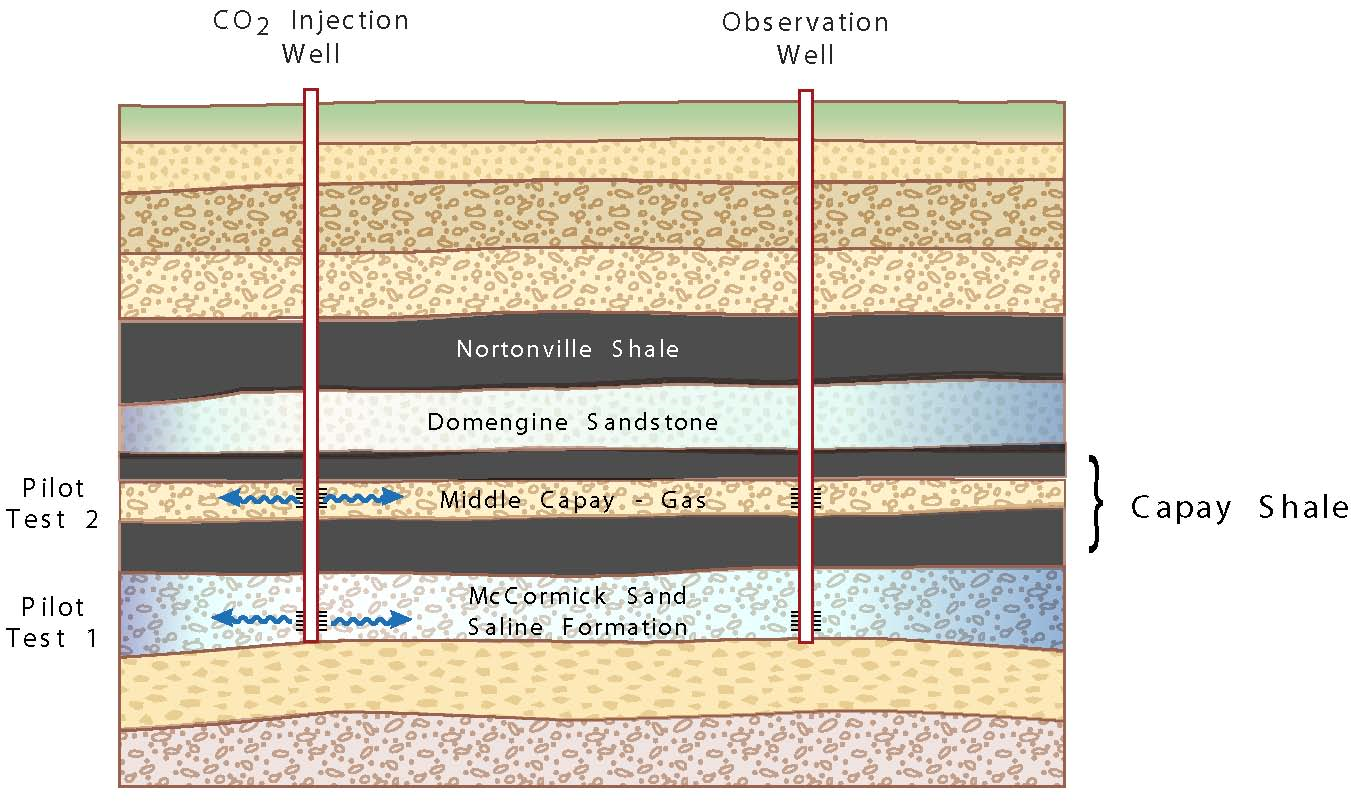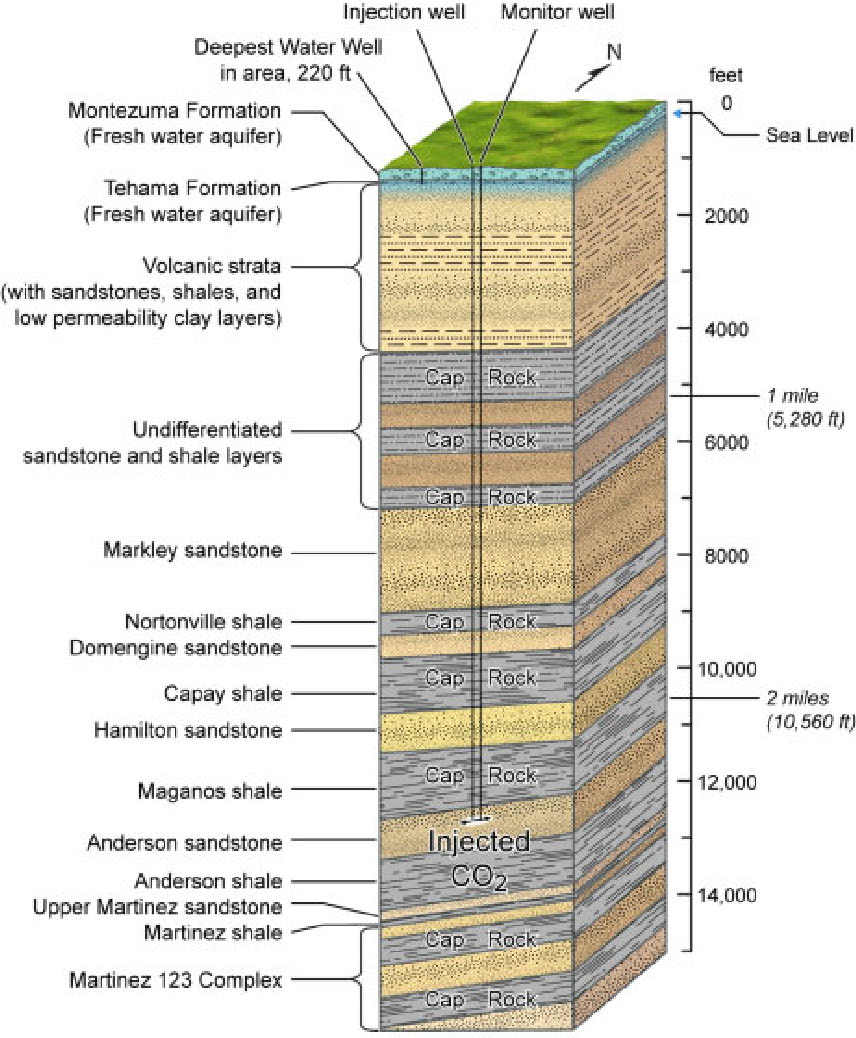Site: California CO2 Storage Pilot – Montezuma Hills Site
Type: Saline
Operator: C6 Resources (Shell)
Source: Industrial Facilities (refineries) in the San Francisco Bay Area
Lat/Long:
Montezuma Hills proposed appraisal well site: N 38°06’59.12”, W 121°50’18.28”
Why This Location?
The California Montezuma Hills site was one of three sites for the West Coast Regional Carbon Sequestration Partnership (WESTCARB) characterization studies representing promising opportunities in the southern Sacramento Basin in California. The site selection was based on several factors. Laterally continuous sandstones and marine shales provided assurance of sufficient storage and multiple containment zones – five formation/seal pairs of strata were identified as potential candidates for carbon dioxide (CO2) injection and testing. Other factors included favorable terrain with low-environmental sensitivity and good surface access, very few old well penetrations, low-population density, and proximity to pipeline corridors and refineries.
Main Research Q&As Discovered
The goal of the Phase II California carbon dioxide (CO2) storage pilot project was to characterize the site geology, determine reservoir conditions and parameters, provide input to the site geologic concept model, and support a possible scale-up to commercial-scale. A key part of the characterization was the proposed injection of 6,000 metric tons of CO2 from an appraisal well at the site. In the proceedings for the land use permit, Solano County required investigation of the potential for induced seismicity from the 6,000-metric-ton injection. The regulators specifically framed the induced seismicity question as “What is the likelihood of the CO2 injection causing a magnitude 3.0 (or larger) event?” Naturally occurring earthquakes at great depth as large as magnitude 3.7 had been recorded over the last 32 years in association with the Kirby Hills Fault, the closest known active fault to the site. Researchers reviewed available information, including the 32 years of recorded seismic events, evidence of faulting from proprietary seismic data over the site, and indicators of the stress state of the region. Numerical simulation models showed that the pressure increase on the Kirby Hills Fault due to the injection of 6,000 metric tons of CO2 would be a tiny fraction of the natural pressure reservoir and would decrease rapidly after injection stopped. Researchers concluded it was unlikely that the small-scale CO2 injection would cause a magnitude 3.0 or larger event in the study area and even more unlikely that events would be induced at the significantly greater depths where most of the recorded earthquakes are concentrated. However, there were many uncertainties associated with this analysis, and researchers recommended further characterization of known faults in the area of study; seismic monitoring before, during, and after injection; assessing the in-situ stress state at the site; geomechanical modeling; and developing a protocol for induced seismicity.
Lessons Learned that Impacted Phase III Design?
The California carbon dioxide (CO2) storage pilot project performed valuable site characterization at the Montezuma Hills site; however, the appraisal well was not drilled and the project did not execute CO2 injection. The findings from the work conducted at these sites can help the region better assess geologic storage options for meeting greenhouse gas (GHG) reduction targets, as well as helping natural gas producers determine how CO2 injection may extend the life of depleted natural gas fields.
Story of Interest
The Montezuma Hills site was the proposed injection location for a first-of-its kind, large-scale, integrated saline storage and capture project with a refinery as the carbon dioxide (CO2) source. The integrated project involved capture of 710 metric kilotons per year of CO2 from three steam methane reformer (SMR) units located at the Shell Martinez Refinery in Contra Costa County. The CO2 streams vented from two of the SMR units were approximately 98% pure, so capture required only piping to take the vent streams to dehydration and compression facilities. However, the third unit incorporated a pressure swing absorber (PSA). In this case, it was proposed to capture the CO2 from a syngas stream upstream of the PSA using the Honeywell UOP SelexolTM process. The project included a pipeline designed to carry as much as 1.4 million metric tons per year of CO2 in order to accommodate CO2 captured from other industrial sources in the Bay Area. The appraisal well was not drilled at Montezuma Hills because of an internal business decision by Shell to abandon the integrated project.
Geologist Rock-Fest Call Out
The California carbon dioxide (CO2) storage pilot project at Montezuma Hills took place in the southwestern Sacramento Basin in California. Alternating layers of sandstones and thick marine shales provide several options for storage. The Montezuma Hills site is underlain by an asymmetric structural syncline. Available 2D seismic data shows no faults in the central part of the synclinal area where the target saline formations are located. The regionally extensive Domengine, Hamilton, Anderson, and Martinez sandstone formations were identified as potential storage targets. The sandstones are deep, thick formations with high permeabilities, deposited in shallow marine, estuarine, deltaic, and submarine fan environments. They are all overlain by laterally extensive marine shales. The available seismic data in the area do not indicate that the stratigraphy of any of the seals are eroded or interrupted in the vicinity of the Montezuma Hills site. Less is known about the Martinez sandstone porosity and permeability and the overlying Anderson and Martinez shale.





